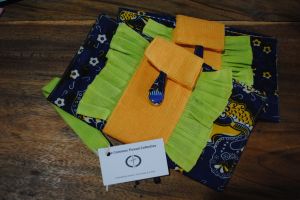This piece makes me really, really happy. While it may be simple, it was a turning point for our intermediate students. It was the first time they worked with sturdy interfacing, and, there were hardly any re-dos.
Our advanced students championed this little clutch and learned the bag (language barriers, translation hilarity, and all) in only half a morning. When we first began, our students took almost a full day to simply sew a straight line on paper. Our first bag was a very basic flat bottom tote, and it took three days to learn.
With the introduction of our intense new curriculums and a restructure of the courses, you can actually see the tailors begin to make connections. On lunch break, they sit outside with their bags and start to break them down, discussing how they were made. They do this with their blouses, their dresses, and even, their shoes.
To think that two years ago they told me, “We want to learn but we know we could never make something like that,” as they pointed to my messenger back.
It is absolutely amazing to watch them prove themselves wrong.
While this is a great step, we still have many more to make. We desperately want to upgrade our compound to allow for solar panels. Sewing on treadle machines makes some limitations to what materials you can use and without a free arm to the machine, makes some designs hard to execute.
Within two years, we want to break ground on our own compound with separate rooms for each curriculum. We want to introduce energy sustainability to avoid the common crash of rural electricity shortages, and we want to start on our mission that the students themselves have set upon us. Stop the garment industry from enslaving women and keeping them in poverty.
Think about that. This idea didn’t evolve over coffee in an upper middle class neighborhood. It evolved in the foothills of Uganda, from 7 women who once called themselves peasants and believed they had no future. It evolved when they saw me reading the news of the Bangladesh fire with my laptop propped up on our pattern cutting table.
They were horrified. They hugged me. They thanked me that I kept them from that fate. Little do they know, that fate could be just down the road in Kampala.
But it doesn’t have to be that way. We are educating and producing a new crop of students that will be well versed in garment and accessory design and production. With the right machinery, we can utilize those skills to offer not only training, but good paying and safe employment. We can pass the savings on to the major labels because we are out to empower our employees, not pad our pockets.
Thanks to trade regulations, we can send qualifying product with decreased duty.
This is why this tiny little, brightly colored bag gives me hope. The green and orange fabrics are hand woven and hand dyed for us in Kampala at a co-op. The kitenge is purchased from our favorite market that is run by one of the sassiest ladies in all of Uganda. The bag is sewn by a woman who once sold herself on the street corner at night to feed her children, trying to make sure she didn’t have to bring them to work with her (not to visit, but to also work).
The idea, the impact, the possibilities. They’re all there, and they are all strong.
Want to join in the fight?
Send us a note, inquiries@thecommonthreadcollective.org
